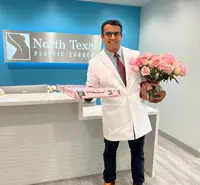BABY BORN WITH VIRTUALLY NO JAW UNDERGOES UNIQUE SURGERY TO HELP BONE GROW
Star-Telegram, December 25, 2009
On the day before Christmas, a 2-week-old baby named Don lay on an office-based surgical facility table as his tiny jaw was broken in three places.
A device was attached with screws that will gradually pull apart the fractured bone by a millimeter a day.
It’s part of a procedure that Dr. Sacha Obaid hopes will change the future for babies such as Don, who are born with virtually no jaw and are at risk of suddenly dying from a blocked airway.
The surgery should allow the bone to lengthen and fill the gap.
“The small movements over time add up to a huge change,” said Obaid, a Southlake plastic surgeon. “We are literally tricking the body into growing a new jaw.”
It will be about a month before Don can leave Cook Children’s Medical Center in Fort Worth with a new jaw and a chance for the kind of life that would not be possible without the operation.
A year from now, there should be little evidence of all this baby has been through. His birth mother, who did not know she was pregnant until the 9-pound baby arrived in early December, decided to place the baby for adoption, said Tanya Houk, a caseworker at the Gladney Center for Adoption.
His transitional care parents, Mary and Steve Weis, will care for him until he is placed with a permanent family. This year, Gladney has placed quite a few babies with heart problems and other medical conditions, including two who were terminally ill, Houk said. Treatment is often covered by the birth mother’s Medicaid or insurance.
Don was born with Pierre Robin sequence, a birth defect characterized by a small lower jaw, a cleft palate and a tongue that balls up in the back of the mouth and causes breathing problems. Babies with this birth defect face challenges beyond their physical scars.
Without the surgery, Don would likely be unable to eat or speak. Traditional procedures involve a tracheotomy, or a hole in the throat, and patients must be fed through a tube in the stomach, sometimes for the rest of their lives. In some cases, the baby’s tongue is sewn outside of his mouth to prevent breathing problems, said Obaid, who specializes in pediatric craniofacial surgery.
“But the biggest problem is, because they can’t breathe well, they have to have round-the-clock care,” Obaid said. “And the trach easily gets plugged up, which can lead to death.”
In 2008, he brought the new surgical technique, called mandibular distraction, to North Texas after studying with his mentor, Dr. Joseph McCarthy, who pioneered the surgery a decade ago.
During a five-hour surgery on Thursday, Obaid used a saw, hammer and chisel to break Don’s lower jaw. He then attached the device that will gradually pull the bone apart and stimulate new growth. The small screw in his chin will be turned twice a day to gently pull the bone apart. Growing the bone and turning the screw each day is not painful, Obaid said.
Before Don leaves the hospital, he will have to learn how to eat through his mouth, something he has been unable to do since birth. The device will stay in place for two months after that to give the bone time to harden.
“Once the bone is hard and solid, then we take him back to the [office-based surgical facility] to remove the device,” Obaid said.
After a year, it will be difficult to see the tiny scar under his jaw.
As Don gets older, the jawbone will continue to grow. It’s possible that a second surgery may be needed to lengthen the bone when he becomes a teenager.
Long before he reaches that point, Don will be adopted, possibly when he goes home from the hospital, Houk said.
“By this time next year, he’s going to be perfectly fine,” she said. “He’ll be great.”
INFANT RECOVERS FROM FIRST FACIAL CLEFT SURGERY
Copperas Cove Leader Press, May 26, 2009Katie Barbour knew her baby would have some deformities at birth, but what the doctors expected to be a baby girl with a cleft lip and pallet was in actuality a baby boy with a total facial cleft extending up into his eye sockets causing him to be blind.
Even though Barbour ended up with more on her plate than she expected, she said it didn’t bother her.
“You don’t feel (anything) when it’s your own baby,” she said about her first reaction to seeing her son.
She delivered John Tre “JT” Barbour at Cook Children’s Hospital in Fort Worth seven months ago. Doctors immediately took him away for testing. At first they believed JT had facial dysplasia, but plastic surgeon Dr. Sacha Obaid later diagnosed him with a total facial cleft No. 4. There have only been about 40 diagnoses of this kind in the world, said Barbour.
JT was able to go home with his mother and father, John Laura, 13 days after birth. The only special advice from the doctors was to use a bottle for cleft lips, but Laura said JT wouldn’t drink from it. He now drinks formula using a standard baby bottle, but at nearly twice the age most infants start eating baby food he is still on a liquid diet since he lacks the hard pallet necessary to eat solid food.
Tuesday, May 12, JT started his journey toward being able to eat and develop as a normal child with his first facial reconstructive surgery. Dr. Obaid who specializes in cranial facial procedures, was able to put JT’s lips together, give him lower eyelids using tissue from his cheeks and move his nose down from where it sat directly between his eyes.
The procedure took about six-and-a-half hours and cost more than $9 million. Unfortunately, the family is facing some difficulty with Medicaid since this governmental body considers many of the procedures cosmetic.
JT was released from the hospital Sunday, May 17. His next surgery is scheduled for July where his top eyelids will be created and his small-underdeveloped eyeballs will be removed and replaced with silicone ones. A third surgery is planned for November to give JT a hard pallet and connective bones around his nose.
Barbour said doctors have told her he is fine developmentally wise and should be able to start school on time; however, he will most likely start walking late due to his blindness.
Due to the time and attention baby JT needs, his parents have moved from Oklahoma to live with Copperas Cove resident Brandy Bukszpan. Barbour is originally from North Texas and Laura, a former soldier, is from Milwaukee.
“They focus 24 hours on this child and they are really great parents,” Bukszpan said. “I tell them that every day. They are so good and so patient.”
And JT’s needs rule their daily schedule.
“I can’t have a job because no job will let me off for as long as I have to be at the hospital,” Barbour said.
“We can only take it one step at a time,” Laura said. “The future only holds what JT gives us. We can’t do anything outside what he wants. He is in charge.”
DR OBAID IN SOUTHLAKE STYLE MAGAZINE, OCTOBER 2008























